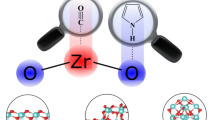Abstract
The nature of the interaction between trifluoromethanesulfonic acid (triflic acid) and the surface groups of silica as a support has been investigated by1H and19F-NMR studies. The19F-NMR spin-lattice relaxation time (T 1) dependence on temperature suggests that the dominant relaxation mechanism for19F is a combination of spin-rotation (SR) interactions, one of which seems to be quenched by cage-like structures. This mechanism is activated by the treatment followed to stabilize the acid on silica. Hydrogen proton relaxation seems instead to be driven by dipolar interactions and the formation of hydrogen bridges. Activation energies have been estimated for various cases, assuming an Arrhenius-type temperature dependence for the correlation times of molecular motion. A linear dependence of1H chemical shift on inverse temperature was also found, which is interpreted as thermal weakening of hydrogen bonding. The results support the conclusion that the stability of triflic acid on silica is due to the formation of strong hydrogen bridges between the sulfonic groups of triflic acid and the silica surface hydroxyls, provided a network structure similar to that observed for pure acid is obtained in which strong interactions between acid molecules occur. The acid seems to be organized as solid-like “drops” on the silica surface, which accounts for the long residence time on the silica surface.
Similar content being viewed by others
References
Clerici M.G., Perego C., de Angelis A., Montanari L.: EP0638363 (1994)
Arnold J.T.: Phys. Rev.102, 136 (1956)
Forsen S., Hoffman R.A.: J. Chem. Phys.39, 2892 (1936)
Zundel G.: Hydration and Intermolecular Interaction, chapter 5. New York: Academic Press 1969.
Lennard-Jones J., Pople J.A.: Proc. Roy. Soc. A205, 155 (1951)
Abragam A.: The Principles of Nuclear Magnetism, chap. 8. London: Oxford University Press 1961.
Brown R.J.C., Gutowsky H.S., Shimomura K.: J. Chem. Phys.38(1), 76 (1963)
Hubbard P.S.: Phys. Rev.131(3), 1155 (1963)
Howells R.D., McCown J.D.: Chem. Rev.77, 69 (1977)
Author information
Authors and Affiliations
Rights and permissions
About this article
Cite this article
Montanari, L., de Angelis, A. & Carati, C. Nuclear magnetic resonance studies of surface interactions between trifluoromethanesulfonic acid and silica. Appl. Magn. Reson. 12, 329–339 (1997). https://doi.org/10.1007/BF03162199
Received:
Revised:
Issue Date:
DOI: https://doi.org/10.1007/BF03162199




